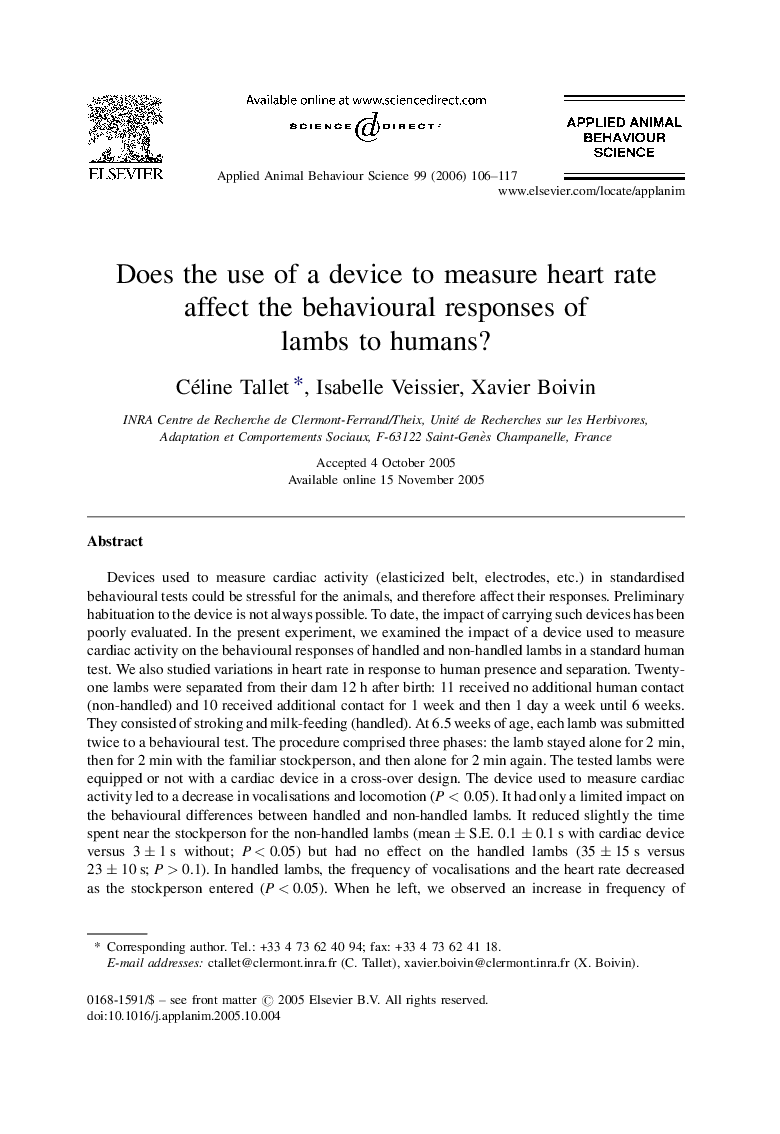| کد مقاله | کد نشریه | سال انتشار | مقاله انگلیسی | نسخه تمام متن |
|---|---|---|---|---|
| 4524205 | 1625444 | 2006 | 12 صفحه PDF | دانلود رایگان |

Devices used to measure cardiac activity (elasticized belt, electrodes, etc.) in standardised behavioural tests could be stressful for the animals, and therefore affect their responses. Preliminary habituation to the device is not always possible. To date, the impact of carrying such devices has been poorly evaluated. In the present experiment, we examined the impact of a device used to measure cardiac activity on the behavioural responses of handled and non-handled lambs in a standard human test. We also studied variations in heart rate in response to human presence and separation. Twenty-one lambs were separated from their dam 12 h after birth: 11 received no additional human contact (non-handled) and 10 received additional contact for 1 week and then 1 day a week until 6 weeks. They consisted of stroking and milk-feeding (handled). At 6.5 weeks of age, each lamb was submitted twice to a behavioural test. The procedure comprised three phases: the lamb stayed alone for 2 min, then for 2 min with the familiar stockperson, and then alone for 2 min again. The tested lambs were equipped or not with a cardiac device in a cross-over design. The device used to measure cardiac activity led to a decrease in vocalisations and locomotion (P < 0.05). It had only a limited impact on the behavioural differences between handled and non-handled lambs. It reduced slightly the time spent near the stockperson for the non-handled lambs (mean ± S.E. 0.1 ± 0.1 s with cardiac device versus 3 ± 1 s without; P < 0.05) but had no effect on the handled lambs (35 ± 15 s versus 23 ± 10 s; P > 0.1). In handled lambs, the frequency of vocalisations and the heart rate decreased as the stockperson entered (P < 0.05). When he left, we observed an increase in frequency of vocalisations but no change in heart rate (P > 0.1). No change in heart rate was observed for the non-handled lambs.We conclude that the device used to measure cardiac activity led to a general decrease in activity but did not affect the difference between handled and non-handled lambs. Consequently, this method seems to be appropriate for further exploring artificially reared lambs’ perception of humans, with few risks of behavioural alterations. However, the absolute values of locomotor and vocal activities should be taken with caution. Behavioural and physiological measures were not totally consistent, which questions then-respective emotional significance.
Journal: Applied Animal Behaviour Science - Volume 99, Issues 1–2, August 2006, Pages 106–117